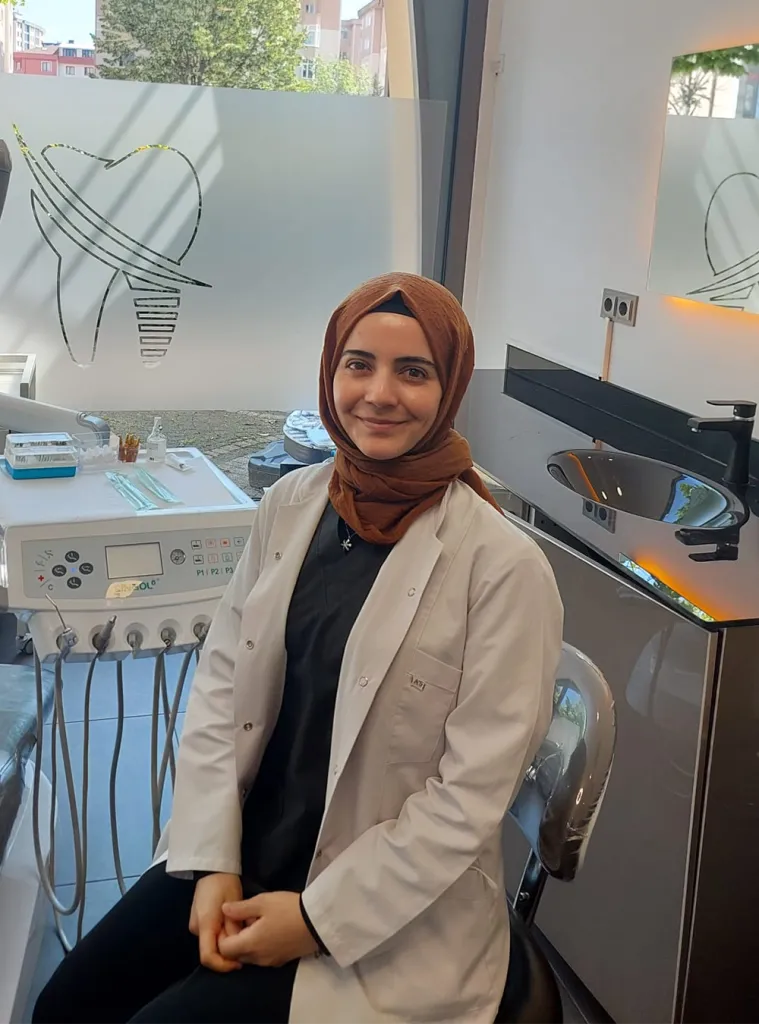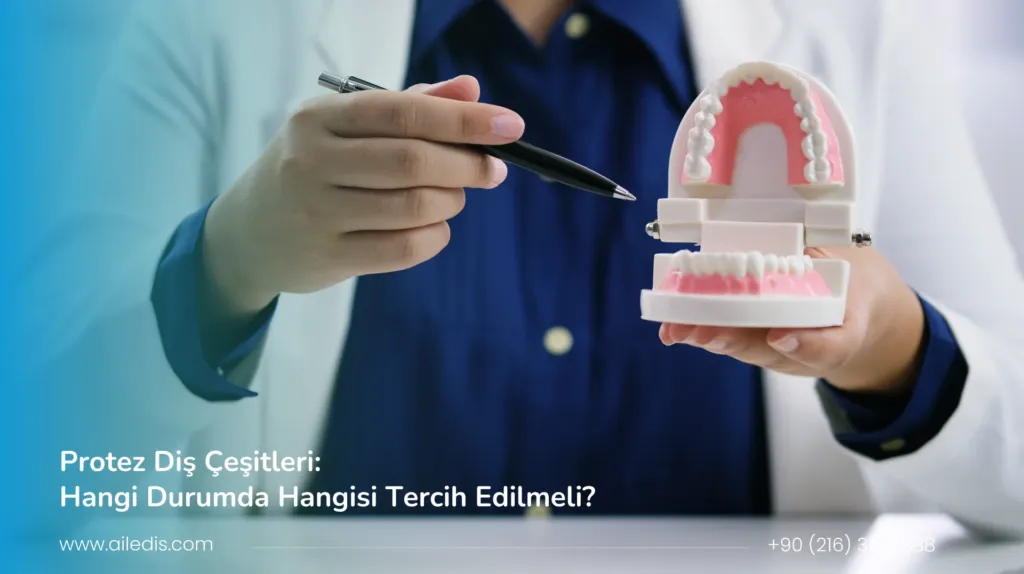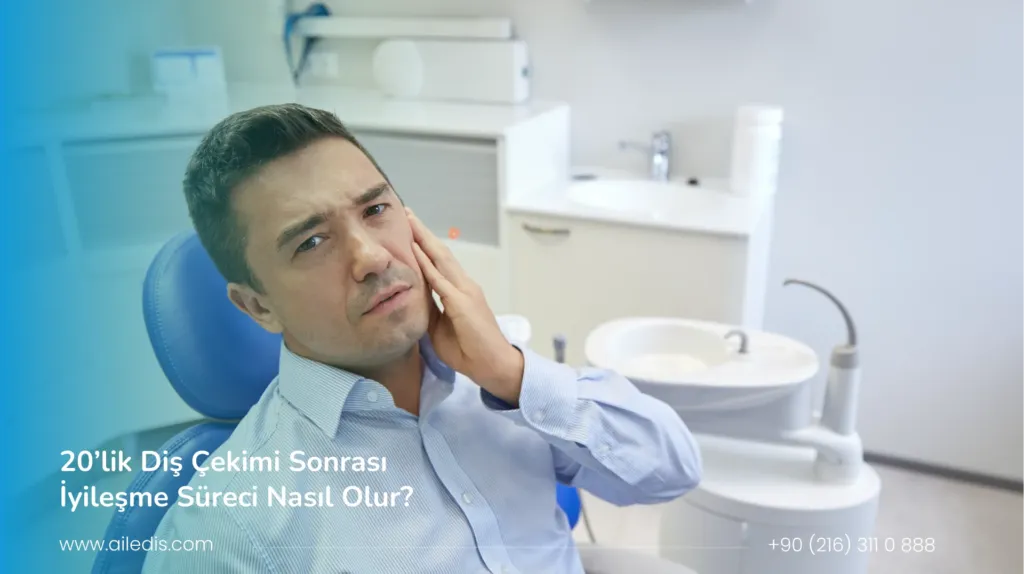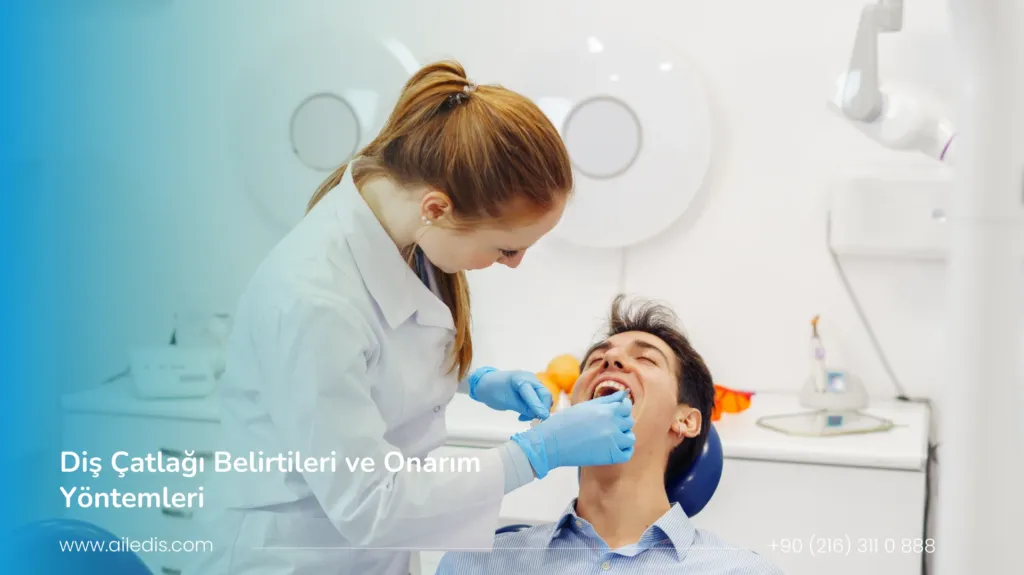bleeding gumsIt is a common oral health problem that most people face at least once in their life. However, this is not just a temporary inconvenience; same time An important warning sign about oral hygiene and general dental health maybe.
Bleeding of the gums is usually caused by reasons such as gingivitis (gingivitis), improper brushing habits, or insufficient dental floss. If untreated, this condition is more advanced. periodontitis It can turn into serious gum diseases such as
PRIVATE FAMILY DENTAL CLINICIt offers both early diagnosis and effective treatment options to its patients with bleeding gums. Our expert team develops long-term solutions with personalized care plans and professional cleaning practices to protect the health of the gums.
In this article, Causes, symptoms and treatment methods of bleeding gums You will find comprehensive information about it.
You will also learn ways to strengthen your gums with simple measures you can take at home. For a healthy, bleed-free and aesthetic smile Family Dental Clinic You can take a step under expert guidance.
What is gingival bleeding and what does it mean?
Gum bleeding is a condition that occurs as a result of inflammation of the gums. It usually occurs during brushing or flossing and indicates that oral health is neglected.
This discomfort may be the onset of periodontal diseases, as well as a symptom of systemic health problems. Bleeding in the gums is a warning that should be taken seriously and is important to be treated with early intervention.
The first signs of bleeding gums
The first signs of bleeding gums are usually easy to notice. Bleeding while brushing or using dental floss is one of the most common signs of this condition. Swelling and redness of the gums can also be observed.
These symptoms can be a sign of problems that can be treated with early intervention. If the mouth is accompanied by a bad taste or bad breath, it is important to take care of your gum health. It is necessary to be sensitive to such symptoms.
Differences between temporary and persistent bleeding
Temporary gingival bleeding usually occurs during brushing or flossing. This type of bleeding often goes away on its own, when attention is paid to oral hygiene, and it is not worrying.
Constant bleeding may indicate a more serious condition. Regular bleeding of the gums can be a sign of health problems such as infection or periodontal disease. In this case, it is necessary to consult a dentist.
The main causes of bleeding gums
Among the most common causes of bleeding gums Accumulation of plaque and tartar, , gingival recession, , systemic diseases and Incorrect brushing techniques takes place. Inadequate oral hygiene causes inflammation in the gums, paving the ground for bleeding.
PRIVATE FAMILY DENTAL CLINICemphasizes that bleeding gums is not only a local problem, but also may be related to general health. Systemic disorders such as diabetes and heart diseases can adversely affect gum health.
The following table summarizes the main factors that can cause bleeding gums:
| Why is that | Affected area | probable outcome |
| Accumulation of plaque and tartar | Tooth and gum line | Inflammation, gingival recession |
| gingival recession | root surface | tenderness, bleeding |
| systemic diseases | Blood circulation and immune system | Increased risk of infection |
| Incorrect brushing | gingival tissue | Trauma, bleeding and irritation |
The role of plaque and tartar (toothstone)
accumulated in the mouth recordIt is a bacterial layer that forms on the teeth. It hardens when not cleaned and scale (tooth calculus). When the tartar is placed below the gum line gingivitis (Gum gingivitis) develops, which leads to bleeding.
Regular tooth brushing, flossing and professional tartar cleaning are the most effective methods in preventing gingival bleeding. Otherwise, the inflammation progresses periodontitis It can turn into more serious diseases such as
Gingival recession and bleeding relationship
gingival recessionIt is the situation in which the gums are separated by separating the tooth roots. This exposes the root surface of the teeth and makes the area tender. As a result, bleeding may occur during brushing or eating.
Gingival recession is usually Inflammation, clenching (bruxism) or aging due to. This situation can be prevented from progressing with regular controls and correct brushing techniques.
Effect of systemic diseases on gingival bleeding
bleeding gums, existing in the body A symptom of systemic diseases maybe. Especially diabetes, cardiovascular diseases and immune system disorders cause inflammation in the gingival tissues.
In addition, hormonal changes — especially pregnancy and adolescence periods — can cause the gums to become more sensitive. For this reason, gingival bleeding should be considered not only as a local problem, but also as an indicator of general health.
Incorrect brushing and flossing
Brushing over-pressed or by the wrong technique trauma and bleeding may cause. The correct brushing direction is as important as the choice of toothbrushes. Cleaning with circular and gentle movements provides effective cleaning without damaging the gums.
Care should be taken when using dental floss. Cleaning with sudden movements can lead to minor injuries to the gingiva. Using dental floss gently between the teeth is the basis of a healthy gingival care.
Symptoms and early warning signs in bleeding gums
The first signs of bleeding gums are usually Swelling, redness, pain and bad breath emerges in the form. These findings indicate early stages of gingivitis.
If the gums are healthy, they are pink and have a tight structure. If it turns dark red or bleeds during brushing, this is a warning sign. Early intervention during this period can prevent progressive gum diseases.
Symptoms of swelling, redness and pain
Gingival bleeding is usually Swelling, redness and tenderness accompanies. Swollen gums can be a sign of bacterial infection. Redness indicates an increase in blood flow in the area.
The pain sensation usually occurs during brushing or while eating. These symptoms indicate that the defense mechanism of the gums is activated and fights inflammation.
Bad breath and gingival discolorations
Bad breath (halitosis) is a common result of gum diseases. The increase of plaque and bacteria causes an unpleasant odor. The prolonged duration of this condition may indicate that the inflammation has become permanent.
The color of the gums also gives important clues about the state of health!
- pink: healthy gums
- Red: onset of inflammation
- Purple shades: Symptoms of chronic periodontitis
When these color changes are noticed, the dentist should be consulted without delay.
Treatment methods for bleeding gums
Treatment of gingival bleeding varies according to the cause. While regular cleaning and correct oral care are sufficient in mild cases, professional interventions may be required in advanced cases.
The main treatment approaches:
- Medication (antibiotic, gargle, anti-inflammatory drugs)
- Professional dental calculus (detartrage)
- Surgical treatments (cleaning of periodontal pockets, tissue regeneration operations)
In any case, the correct treatment plan should be determined by a dentist.
Drug treatment approaches for bleeding gums
To reduce bacteria that cause gingivitis Antibiotic and antiseptic mouthwash treatments can be applied. Anti-inflammatory drugs relieve swelling and pain.
But drugs are only supportive treatment. The main solution is to eliminate the source of the infection. For this reason, drug treatment should be supported with tartar cleaning and regular care habits.
Professional dental calculus (detartrage)
calculus cleaningis a professional procedure performed by the dentist. Cleaning the accumulation of plaque and tartar with special devices quickly improves gum health.
Regular deterrative treatment (at least twice a year) both prevents gingival bleeding and makes oral hygiene permanent. After the procedure, mild tenderness in the gums is normal and goes away in a short time.
Situations requiring surgical intervention
Bleeding gums in some advanced cases periodontal surgery may require. In cases where deep gingival pockets are formed, surgical cleaning is performed. In addition, tissue graft applications can be made to recover lost tissues.
In patients with a high risk of tooth loss, the gingival tissue is repaired or Implant treatment alternatives such as Such procedures should only be performed by specialist physicians.
Home care and oral hygiene recommendations for bleeding gums
Home care and correct oral hygiene habits are the most important complements of the treatment process for people with bleeding gums. A regular and conscious cleaning routine helps strengthen the gums and reduce the risk of inflammation.
PRIVATE FAMILY DENTAL CLINIC, offers both professional cleaning and effective care recommendations that can be applied at home to its patients who have bleeding gums.
An oral care routine supported by correct brushing, flossing and antiseptic mouthwash twice a day forms the basis of maintaining gum health.
In addition, a diet rich in vitamin C contributes to the strengthening of the gums.
Correct brushing and flossing
The most basic step to prevent bleeding gums is the correct brushing technique.
Brush your teeth at least twice a day with a soft-bristled brush in circular motions. The brushing time should be at least two minutes and the gums should not be overpressed.
The use of dental floss also reduces the risk of bleeding by removing plaque and food residues accumulated between the teeth. Regular flossing once a day is especially effective in preventing gingivitis.
Simple rules that can be applied at home:
- Direct the brush to the gums at an angle of 45°.
- Do the brushing with gentle circular movements.
- Use the floss by moving it forward and backward in each tooth space.
- Refresh your brush every 3 months.
The effect of mouthwash and mouth shower
Mouthwash is an important aid that promotes gum health. Antiseptic mouthwashes prevent bacteria from multiplying and reduce gingival bleeding. It also removes bad breath and provides freshness.
Mouth shower, on the other hand, provides effective cleaning in areas that cannot be reached by brushing and dental floss.
This device removes plaque and bacteria accumulations between the water pressure and the teeth.
Regular use both prevents the progression of gum diseases and makes the gums look tighter and healthier.
| Application | benefit |
|---|---|
| antiseptic mouthwash | Reduces bacteria and inflammation |
| mouthwash | Provides deep cleaning |
| Fluoride Products | Strengthens tooth enamel |
Contribution of nutrition to gingival health
Gum health is directly related to eating habits.
Foods rich in vitamin C, vitamin A and omega-3 fatty acids increase the resistance of the gums and support the healing process.
It is beneficial to regularly consume foods such as oranges, kiwis, spinach and fish.
On the other hand, sugary and processed foods can trigger gum diseases.
Daily water consumption is also very important; Drinking enough water facilitates the cleansing of the oral bacteria and supports the production of saliva.
Points to consider:
- Avoid sugary snacks.
- Limit the consumption of acidic beverages.
- Include fresh fruits containing vitamin C.
- Drink at least 2 liters of water a day.
When does gingival bleeding a harbinger of a serious problem?
Gingival bleeding is usually caused by simple reasons, but in some cases Early symptoms of more serious health problems maybe.
Constant recurrent or severe bleeding may be associated with advanced gingival diseases, as well as systemic diseases such as diabetes, hormonal imbalance or blood clotting disorders.
If your gums are bleeding with every brushing or if you feel swelling and pain, in this case, Family dental clinicYou need to make an appointment.
Early diagnosis and professional cleaning practices prevent permanent results such as gingival recession and tooth loss.
Things to do in continuous and severe bleeding
Constant bleeding gums may indicate that the infection is progressing. In this case, it is necessary to get professional support instead of home applications.
PRIVATE FAMILY DENTAL CLINICIn the treatment of gingival bleeding, it first determines the cause of the inflammation, then it restores the gums to its health with professional calculus cleaning and if necessary drug treatment.
The basic treatment steps in the clinic are:
- Detailed gingival examination and plaque analysis
- Dental cleansing and root surface straightening
- Antiseptic mouthwash and local treatment applications
- Regular control sessions
These steps allow the bleeding to stop completely and the gums to become firm and healthy again.
In which cases should a dentist be consulted?
If gingival bleeding becomes severe, if it is accompanied by symptoms such as discoloration or recession in the gums, a dentist should be consulted.
In addition, conditions such as bad breath, shaking of teeth or tenderness require professional examination.
Gum diseases can be completely controlled with early intervention.
Therefore, Family dental clinicHaving regular check-ups and applying personal care recommendations is the most effective way to protect your oral health in the long run.
Periodontal (Gum) Treatment Process in Private Family Dental
The periodontal treatment process in Private Family Tooth starts with the gingival examination. Specialist physicians apply the necessary diagnostic methods to evaluate the health of the gums. This stage is of great importance for the early detection of possible problems.
After the examination, a personalized treatment plan is created. Various methods can be applied considering the needs of the patient during the treatment process. Regular controls play a critical role in the effectiveness of treatment and support the healing process.
Gingival examination and diagnostic methods
gingival examination, dentist is an important control. In this process, the condition of the gums, the presence of bleeding and their depths are evaluated. In addition, the gaps between the teeth are also examined.
Diagnostic methods include X-rays and the use of periodontal probes. While bone loss can be detected with x-rays, the periodontal probe determines the severity of the gum disease by measuring the pocket depth. With these data, it is possible to create personalized treatment plans.
Personalized periodontal treatment plan
Personalized periodontal treatment planIt is prepared by taking into account the gum health and needs of each patient. This plan is created by considering the individual’s mouth structure, current problems and general health status.
The treatment process usually starts with a detailed examination. Your dentist determines the most effective solution methods by performing the necessary tests. Thus, the treatment process becomes more efficient and the health of the gums is quickly restored.
Post-treatment controls and follow-up
Regular check-ups are very important after gingival bleeding treatment. Your dentist can intervene when necessary by following your healing process. Monitoring the health of your gums with control appointments prevents recurrent problems. In addition, it will be very useful to comply with the doctor’s recommendations in this process. Paying attention to your personal care and sticking to the recommended treatment plan helps protect your gum health. Remember that oral hygiene plays a critical role not only for your teeth, but also for your general health.







Frequently Asked Questions for bleeding gums
Is bleeding gums normal?
No, bleeding gums are not normal. They are usually caused by gum inflammation, plaque buildup, or improper brushing habits. They can be prevented with regular care and professional cleaning.
Does gum recession cause bleeding?
Evet, çekilen diş etleri hassaslaşır ve fırçalama sırasında kanama görülebilir. Bu durumda uygun tedaviyle diş eti dokusu korunmalıdır.
Does tartar removal reduce bleeding?
Yes, regular dental scaling reduces gum inflammation and prevents bleeding. Mild bleeding lasting a few days after cleaning is normal.
Which toothbrush is recommended?
Medium-firm, soft-bristled toothbrushes that do not damage the gums should be preferred. Electric toothbrushes also support gum health.
Is a mouthwash beneficial?
Yes, it protects gum health by cleaning plaque stuck between teeth. It is particularly effective for people undergoing orthodontic treatment.
Which vitamin deficiency causes bleeding gums?
Vitamin C and vitamin K deficiency can cause bleeding gums. A balanced diet helps prevent this condition.
Is gum bleeding during pregnancy normal?
During pregnancy, hormonal changes can make gums more sensitive. However, if bleeding persists, a dental check-up is necessary.
Does bleeding gums cause bad breath?
Yes, bacteria multiply in inflamed gums and bad breath can occur. Regular cleaning reduces this problem.
Does mouthwash help after gum bleeding?
An antiseptic or saltwater gargle soothes the gums and helps reduce bacteria. However, professional care is required for a permanent solution.
What happens if gum bleeding is not treated?
If left untreated, gum disease can progress and lead to tooth loss. Bone loss in the jaw may also occur.







